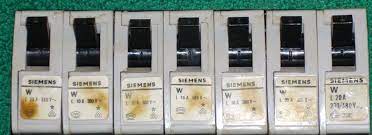Fuse switches
Fuse devices are electric devices that interrupt the flow of current in electric circuits. In order to prevent excessive current from flowing through the circuit, a fuse is installed. There is usually just a short piece of wire attached to a fuse. Fuse materials have a high resistivity and a low melting point, so they melt down when the wire overheats due to high current flow.
As a result of the current flowing in the circuit, the thickness of the fuse wire can be determined. There are many tin and lead alloys used to make fuse wire, which has a low melting point and a high resistance.
To break a circuit causing a flow of excess current, a thin conductor is used, known as an electric fuse, to melt or separate it. A fuse can be sacrificed if something goes wrong in the circuit since they are weak points intentionally placed within the circuit. A fuse panel is often placed close to the cars’ batteries to protect the wiring. This guide is all about fuse switches.
Principle of Fuse switches
Fuse protection prevents short circuits, excessive current, and mismatched loads from damaging electrical equipment. Essentially, electrical fuses function as miniature circuit breakers. Their purpose is not only to protect equipment but to prevent human safety hazards.
Electrical fuses are built in a way that protects the fuse wire from damage when the average amount of current flows through the circuit. Normal conditions result in the fuse wire contributing to the circuitry, allowing charges to flow through it. In spite of this, a large current flowing through a fuse wire may cause the wire to melt due to the heating effect caused by the current. Fuse wire is chosen for this purpose because of its low melting point. Due to this, the circuit is stopped from flowing charges as the loop breaks.
To ensure that the fuse selected is suitable for the circuit in question, it is essential to select the correct fuse. A fuse underrated for normal current conditions will fail even under normal conditions, breaking the circuit loop unnecessarily. An overrated break will cause equipment damage, failure, or even present a safety hazard if it does not break the circuit when required.
Working of fuse switches
Its primary function is to interrupt the circuit if more current is drawn than it should, preventing short circuits from causing harm.
There are many different fuses, but the most basic is composed of a resistive element chosen carefully for its melting point. This element dissipates some power as heat due to a small voltage drop across it (only small enough not to affect the downstream circuit).
Read more:All Important Information That You Must Know About What Is An Control Panels In Electrical?
It increases the temperature of the element. This temperature increase is insufficient to meet the filament when normal currents are used. When the fuse-rated current exceeds the current drawn by the fuse, the melting point is reached within a short period of time. In the event of a melting resistive element, the circuit is disrupted.
Based on the resistive element’s thickness and length, it will determine the rated current. It is common to construct fuse elements from zinc, copper, silver, aluminum, or other metal alloys to generate predictable trip currents. It is important that the element do not oxidize or corrode during its lifetime.
As a result of the high current passing through the fuse, a short circuit, overcurrent, or mismatched load connection causes the fuse’s thin wire to melt. It is because of the “Heating Effect of Current,” which states that the fuse’s thin wire melts when an overload or short circuit occurs.
A power cut occurs, interrupting the power supply to the linked system. During regular circuit operation, fuse wires are a low resistance component that does not affect the operation of the power source-connected system.
Pros of fuse switches
In their various applications, electric fuses provide the following benefits:
- A fuse is an inexpensive and easily replaceable part.
- There is a reduced risk of electrical hazards since electronic fires can result in uncontrolled explosions.
- Appliances can be repaired at a low cost.
- Fuse types range from inexpensive to expensive.
- It doesn’t require any extra maintenance or care.
- The portable nature of these devices makes them easy to transport.
- The circuit is terminated if it is overloaded or if it is overcurrent.
- Fuseless electrical systems can cause electrical faults and burn electric appliances without fuses.
Cons of fuse switches
Fuse technology has some limitations even though it has many advantages. The following are some disadvantages of fuses in various applications:
- There may be some time gaps between the time-current feature and the safeguarding element.
- Due to its reversible time-current capabilities, the device can be used as a safeguard against overloads.
What distinguishes a fused switch from a switched fuse?
A switch switches on or off a circuit in the electrical industry. An inrush’s current condition will cause a fuse, a type of safety interlock device, to “blow” open. These two devices are combined in a single box by a fused button.









